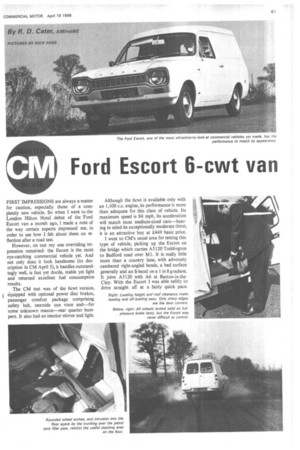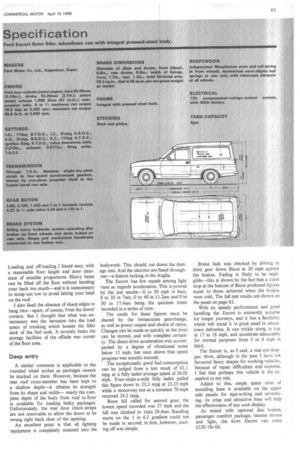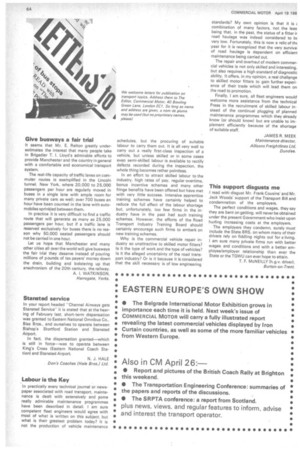(4 1 1 : 1 ) Ford Escort 6-cwt van
Page 63

Page 64

Page 65

Page 66

If you've noticed an error in this article please click here to report it so we can fix it.
performance to match its appearance
FIRST IMPRESSIONS are always a matter for caution, especially those of a completely new vehicle. So when I went to the London Hilton Hotel debut of the Ford Escort van a month ago, I made a note of the way certain aspects impressed me, in order to see how I felt about them on reflection after a road test.
However, on test my one overriding impression remained: the Escort is the most eye-catching commercial vehicle yet. And not only does it look handsome (its description in CM April 5), it handles outstandingly well, is fast yet docile, stable yet light and returned excellent fuel consumption results.
The CM test was of the 6ewt version, equipped with optional power disc brakes, passenger comfort package comprising safety belt, nearside sun visor and—for some unknown reason—rear quarter bumpers. It also had an interior mirror and light. Although the 6cwt is available only with an 1,100 c.c. engine, its performance is more than adequate for this class of vehicle. Its maximum speed is 84 mph, its acceleration will match most medium-sized cars—bearing in mind its exceptionally moderate thirst, it is an attractive buy at £449 basic price.
I went to CM's usual area for testing this type of vehicle, picking up the Escort on the bridge which carries A5120 Toddington to Bedford road over MI. It is really little more than a country lane, with adversely cambered right-angled bends, a bad surface generally and an S-bend on a 1 in 8 gradient. It joins A5120 with A6 at Barton-in-theClay. With the Escort I was able safely to drive straight off at a fairly quick pace.
Right: Loading height and roof clearance make loading and off-loading easy. Only sharp edges are the door corners.
Below, right: All wheels locked solid on fullpressure brake tests, but the Escort was
never difficult to control.
Its gearchange and all the controls operated sweetly. And in fact-a rare instanceI have no criticism whatsoever to make of the control lay-out. Full marks to Ford.
Power disc brakes are optional equip. ment. But during CM's test they proved their worth: full pressure stops simply locked all the wheels, making maximum retardation purely a function of tyre adhesion, which was none too brilliant.
However, for general handling I found the India Autovan tyres almost perfectparticularly with regard to lateral and directional stability when crossing plastic white lines and other raised portions of roads. The kerbing buffer on the tyre walls, too, is a good point, surely adding to the tyres' useful life.
The handbrake performance was disappointing: a nominal effort at the lever caused it to travel to the extreme extent of the ratchet, while the retardation achieved was a mere 32 per cent. I suspected that shoe adjustment was called for, but when the vehicle was jacked up it was discovered that this setting was in fact correct. What we did find was that a great deal of slack had appeared in the cable linkage. This gave me the impression that there was either stretch of the inner, or shrinkage (by closure of the coils) in the outer Bowden cable. There was not sufficient time to take further action at that time, but CM is to retest the handbrake shortly.
One of those first impressions which I checked was that jacking up the van to change a wheel might present a problem. I thought that the jacking sleeve was so far forward that the van's loaded back end would tend to lift the front wheel up before the rear could be lifted clear off the ground. I was wrong. In fact the jacking systerr works well enough for wheel changing although I would not recommend it for ust while anyone worked underneath the vehicle, Another impression had been that the panelling was extremely thin gauge-when smacked with the flat of the hand it deflected considerably, producing a sound like a tenor drum! My thought was that this would lead to excessive drumming when driving. But again I was wrong. The Escort is remarkably drum-free, even over road surfaces which I know from experience create the worst possible conditions.
I do not know whether this is due to lack of noise transmission via the tyres from the road, or because the Ford designers have been exceptionally clever with the swageing and radiusing of the body panels. Whatever the reason the result is an almost completely drum-free ride.
No obstructions With the work undertaken by this class of vehicle a driver often has to get in and out. Here, again, the Escort scores. It has no obstructions on the driver's side and nothing on which to knock your knees under the steering wheel. The door opening is of adequate height and width-even a driver above-average in stature and wearing an overcoat can easily get in and out.
On the other hand the only place to put an invoice board or book is a very deep parcel shelf in front of the passenger seat and I found that articles I placed there disappeared into this cavernous recess and were difficult to retrieve. A door pocket would be much more useful.
The rear door pressings are the same as on the Escort's predecessor, the Anglia van.
Loading and off-loading I found easy, with a reasonable floor height and door clearance of sensible proportions. Heavy items can be lifted off the floor without bending your back too much—and it is unnecessary to stoop too low to avoid hitting your head on the roof.
I also liked the absence of sharp edges to bang into—apart, of course, from the doors' corners. But I thought that what was unnecessary was the intrusion into the load space of trunking which houses the filler neck of the fuel tank. It severely limits the storage facilities of the offside rear corner of the floor area.
Deep entry A similar comment is applicable to the rounded wheel arches as packages cannot be stacked on them. However, because the rear roof cross-member has been kept to a shallow depth—it obtains its strength from its shape and width— nearly the complete depth of the body from roof to floor is available for loading bulky packages. Unfortunately, the rear door check-straps are not removable to allow the doors to be swung right back clear of the opening.
An excellent point is that all lighting equipment is completely recessed into the bodywork. This should cut down the damage rate. And the electrics are fused throughout—a feature lacking in the Anglia.
The Escort has few equals among light vans as regards acceleration. This is proved by the test results-0 to 20 mph in 4scc, 0 to 30 in 7sec, 0 to 40 in 11.2sec and 0 to 50 in 17.4sec being the quickest times recorded in a series of runs.
The credit for these figures must be shared by the immaculate gearchange, as well as power output and choice of ratios. Changes can be made as quickly as the lever can be moved, and with complete certainty. The direct-drive acceleration was accompanied by a degree of vibrational noise below 15 mph, but once above that speed progress was notably smooth.
The exceptionally good fuel consumption can be judged from a test result of 43.1 mpg at a fully laden average speed of 30.05 mph. Four-stops-a-mile fully laden pulled this figure down to 23.3 mpg at 23.25 mph while a motorway test at a constant 70 mph returned 24.2 mpg.
Bison hill called for second gear; the lowest speed recorded was 37 mph and the hill was climbed in ltnin 29.4sec. Standing starts on the 1 in 6.5 gradient could not be made in second; in first, however, starting off was simple. Brake fade was checked by driving in third gear down Bison at 20 mph against the brakes. Fading is likely to be negligible—this is shown by the fact that a crash stop at the bottom of Bison produced figures equal to those achieved when the brakes were cold. The full test results are shown on the panel on page 62.
With its speedy performance and good handling the Escort is eminently suitable for longer journeys, and it has a flexibility which will stand it in good stead in abouttown deliveries. It can trickle along in top at 17 to 18 mph, and accelerate adequately for normal purposes from 5 or 6 mph in third.
The Escort is, as I said, a real eye-stopper. Now, although in the past I have not favoured fancy shapes for working vehicles, because of repair difficulties and expense. I feel that perhaps this vehicle is the exception to my rule.
Added to this, ample space clear of moulding lines is available on the upper side panels for sign-writing and advertising: its crisp and attractive lines will help the effectiveness of any such display.
As tested with optional disc brakes, passenger comfort package, interior mirror and light, the 6cwt Escort van costs L520 18s Od. Give busways a fair trial
It seems that Mr. E. Belton greatly underestimates the interest that many people take in Brigadier T. I. Lloyd's admirable efforts to provide Manchester and the country in general with a comfortable and economical transport system.
The real-life capacity of traffic lanes on commuter routes is exemplified in the Lincoln tunnel, New York. where 20,000 to 25,000 passengers per hour are regularly moved in buses in a single lane with ample room for many private cars as well; over 700 buses an hour have been counted in the lane with automobiles sprinkled between them.
In practice it is very difficult to find a traffic route that will generate as many as 25,000 passengers per hour, but if a traffic lane is reserved exclusively for buses there is no reason why 50,000 seated passengers should not be carried in one hour.
Let us hope that Manchester and many other cities all overthe world will give busways the fair trial they deserve instead of pouring millions of pounds of tax payers' money down the drain, building and bolstering up that anachronism of the 20th century, the railway. A. I. WATKINSON, Harrogate, Yorks,
Stansted service
In your report headed "Channel Airways gets Stansted Service" it is stated that at the hearing of February last, short-term dispensation was granted to Eastern National Omnibus Co., Biss Bros., and ourselves to operate between Bishop's Stortford Station and Stansted Airport.
In fact, the dispensation granted which is still in force—was to operate between King's Cross (Eastern National Coach Station) and Stansted Airport.
N. J. HALE Don's Coaches (Hale Bros.) Ltd.
Labour is the Key
In practically every technical journal or newspaper associated with road transport, maintenance is dealt with extensively and some really admirable maintenance programmes have been described in detail. I am sure competent fleet engineers would agree with most of what is written on this subject, but what is their greatest problem today? It is not the production of vehicle maintenance schedules, but the procuring of suitable labour to carry them out. It is all very well to carry out a really first-class inspection of a vehicle, but unless skilled or in some cases even semi-skilled labour is available to rectify defects recorded during the inspection, the whole thing becomes rather pointless, In an effort to attract skilled labour to the industry, high rates of pay, regular overtime. bonus incentive schemes and many other fringe benefits have been offered but have met with very little success. Intensive apprentice training schemes have certainly helped to reduce the full effect of the labour shortage but, unfortunately, too few firms in the industry have in the past had such training schemes. However, the efforts of the Road Transport Industry Training Board should certainly encourage such firms to embark on new training schemes.
Why is the commercial vehicle repair industry so unattractive to skilled motor fitters? Is it the type of work and the type of vehicles? Is it the alleged uncertainty of the road transport industry? Or is it because it is considered that the skill necessary is of low engineering standards? My own opinion is that it is t combination of many factors, not the leas being that, in the past, the status of a fitter ir road haulage was indeed considered to Ix very low. Fortunately, this is now a relic of thE • past for it is recognized that the very survival of road haulage is dependent on efficient maintenance being carried out.
The repair and overhaul of modern commercial vehicles is not only skilled and interesting, but also requires a high standard of diagnostic ability. It offers, in my opinion, a real challenge to skilled motor fitters to gain further experience of their trade which will lead them on the road to promotion.
Finally, I am sure, all fleet engineers would" welcome more assistance from the technical Press in the recruitment of skilled labour instead of the continual plugging of planned maintenance programmes which they already know (or should know) but are unable to implement efficiently because of the shortage of suitable staff.
JAMES R. MEEK Maintenance director, All/sons Freightlines Ltd, Dundee.
This support disgusts me
I read with disgust Mr. Frank Cousins' and Mr. Jack Woods' support of the Transport Bill and condemnation of the employers.
The perfect conditions and wages, they say they are bent on getting, will never be obtained under the present Government who insist upon hurling increasing costs at the employers.
The employers they condemn, surely must include the State BRS, on whom many of their drivers rely on fiddling nights out for a living. I am sure many private firms run with better wages and conditions and with a better employee/employer relationship than ever the State or the TGWU can ever hope to attain.
T. F. McN El LLY (h. g.v. driver), Burton-on-Trent.








































































































































